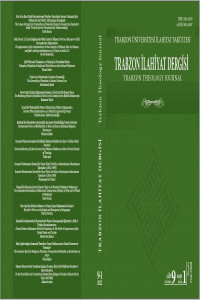Research Article
Aim & Scope
"From Trabzon to the Earth..."
ISSN 2651-4559 | e-ISSN 2651-4567 | Period: Twice a year | Beginning: 2018
Previous Title:
ISSN 2148-5011 | e-ISSN 2618-611X| Period: Twice a year| Beginning- Ending: 2014-2018
Acceptance Period: For June: 01 January-01 April
For December: 01 July-01 October
Trabzon Theology Journal is a peer-reviewed Journal published twice a year as of June and December.
The Journal publishes articles
in Turkish, English, and Arabic.
Our aim is to sustain the publication of scientific research, scientific, objectivity and healthy communication.
Articles submitted to our journal for publication will be subject to double-blind review by at least two referees. Plagiarism report of the articles is revealed through the plagiarism detection program.
Trabzon Theology Journal continues to publish compelling original research which contributes to the development of scholarly understanding and interpretation in the history and philosophy of religious thought, especially in Islamic Studies.
Author Guidelines
Articles prepared for publication in the journal should be written in the Microsoft Office Word (2003-2010) program with Times New Roman font size of 12 pt (only 14 pt) and 1 line spaced and saved as doc or docx.
Page margins should set to: top 3, right 2.5, left 2.5 and bottom 3 cm.
TITLES
Titles should be in Turkish and English language at the beginning of the article. The titles should be short and to reflect on the subject.
Titles should be like this: "1. 2. 3 .; 1.1., 1.2 .; 1.2.1."
The first letters of the words in the titles should be capitalized and the titles should be bold. For example 1. History of Journal 2. The scope of Journal 2.1. Main Scope 2.2. Other Scopes
INTRODUCTION, CONCLUSIONS and REFERENCES title should be written in all capital letters.
Trabzon theology journal requires writers to use the Isnad Citation Style: http://www.isnadsistemi.org
First citation: author(s) first name and last name, title, (if applicable) first and last name of translator or editor, place of publication, publisher, date of publication, page number.
Subsequent citations: author’s last name, the short title, and the page number should be indicated in all subsequent citations. Footnote citations should conform to the following examples.
References: References should be placed at the end of the text in alphabetical order. If a source has more than one author, the surname, and name of the first author should be written, and the other authors should be indicated by et.al. The titles of books and journals should be italicized; article titles and book chapters should be placed in quotation marks. Translator’s and editor’s names (if there are any) should follow the title of the work:
Ethical Principles and Publication Policy
TRABZON ILAHIYAT JOURNAL
The Journal aims to contribute religious, theological, and social studies by publishing original academic works meeting international scientific criteria.
All publishing rights of the articles accepted for publication belong to the Trabzon Theology Journal
All articles sent to TİD are subject to the double-blind peer-review process. Also, all the articles are checked by a plagiarism software (iThenticate) to preclude any academic dishonesty.
We have accepted İSNAD The Isnad Citation Style: http://www.isnadsistemi.org
TİD does not charge for publications and submissions.
Our journal has been accepted to Budapest Open Access Protocol as of 30.12.2018.
The publication process at Trabzon İlahiyat Dergisi- Trabzon Theology Journal is the basis of the improvement and dissemination of information objectively and respectfully. Therefore, the procedures in this process improve the quality of the studies. Peer-reviewed studies are the ones that support and materialize the scientific method. At this point, it is of utmost importance that all parties included in the publication process (authors, readers and researchers, publisher, reviewers and editors) comply with the standards of ethical considerations. Trabzon theology journal expects all parties to hold the following ethical responsibilities.
The following ethical duties and responsibilities are written in the light of the guide and policies made by Committee on Publication Ethics (COPE).
The publication of an article in a peer-reviewed journal is an essential building block in the development of a coherent and respected network of knowledge. It is a direct reflection of the quality of the work of the authors and the institutions that support them. Peer-reviewed articles support and embody the scientific method. It is therefore important to agree upon standards of expected ethical behavior for all parties involved in the act of publishing: the author, the journal editor, the peer reviewer, and the publisher.
1. Publication and authorship:
• List of references, financial support;
• No plagiarism, no fraudulent data;
• Forbidden to publish same research in more than one journal.
2. Author’s responsibilities:
• Authors obliged to participate in peer review process;
• All authors have significantly contributed to the research;
• Statement that all data in article are real and authentic;
• All authors are obliged to provide retractions or corrections of mistakes.
3. Peer review / responsibility for the reviewers:
• Judgments should be objective;
• Reviewers should have no conflict of interest with respect to the research, the authors and/or the research funders;
• Reviewers should point out relevant published work which is not yet cited;
• Reviewed articles should be treated confidentially.
4. Editorial responsibilities:
• Editors have complete responsibility and authority to reject/accept an article;
• Editors should have no conflict of interest with respect to articles they reject/accept;
• Only accept a paper when reasonably certain;
• When errors are found, promote publication of correction or retraction;
• Preserve anonymity of reviewers.
• No plagiarism, no fraudulent data.
•
5. Publishing ethics issues:
• Monitoring/safeguarding publishing ethics by editorial board;
• Guidelines for retracting articles;
• Maintain the integrity of the academic record;
• Preclude business needs from compromising intellectual and ethical standards;
• Always be willing to publish corrections, clarifications, retractions and apologies when needed.
Duties of the Publisher
Trabzon Theology Journal is committed to ensuring that commercial revenue has no impact or influence on editorial decisions. In addition, CTJ will assist in communications with other journals and/or publishers where this is useful to editors. Finally, we are working closely with other publishers and industry associations to set standards for best practices on ethical matters, errors and retractions–and are prepared to provide specialized legal review and counsel if necessary.
Plagiarism Detection
Trabzon Theology Journal uses double-blind review fulfilled by at least two reviewers. In addition, all articles are checked by means of a program in order to confirm they are not published before and avoid plagiarism.
The peer review process is at the heart of the success of scientific publishing. As part of our commitment to the protection and enhancement of the peer review process, CTJ has an obligation to assist the scientific community in all aspects of publishing ethics, especially in cases of (suspected) duplicate submission or plagiarism.
When a reader discovers a significant error or inaccuracy in a paper published in Trabzon Theology Journal or have any other complaint about editorial content (plagiarism, duplicate papers, etc.), he/she should make a complaint by e-mail to: trabzonilahiyatdergisi@gmail.com. We welcome complaints as they provide an opportunity for improvement, and we aim to respond quickly and constructively.
Price Policy
Ücretsiz
Indexes
Citation Indexes
Other Indexes
Journal Boards
Owner on behalf of the Trabzon University, Faculty of Theology
Prof. Dr. Emin Aşıkkutlu
İlahiyat Fakültesi Dekanı
Managing Editor

Editor in Chief

Assistant Editors

Editorial Board




 Web
Web













Special Issue Editor

Field Editors








Language Editor (English)

Book Review Editor

Writing Editors










Tecnical Editor

Ethics Editor

Final Reading










Promotion and Social Media























